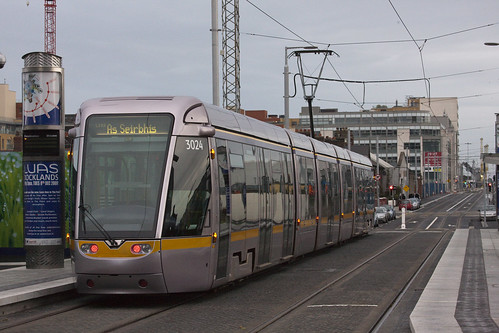LRT Investment is the Right Choice
 (Photo: William Murphy / Flickr)
(Photo: William Murphy / Flickr)
As most people have heard, two weeks ago Prime Minister Harper announced Federal funding for Waterloo Region’s Rapid Transit project. The amount is 1/3 of project costs, up to $265 million, for the first phase of light rail (LRT) and express bus line. But the conversation in local media and by many municipal candidates has shifted to the so-called shortfall. That, horror of horrors, the lower-tier municipality would have to contribute a portion (around $235 million, or less than 1/3) of the capital costs of a long-term transit and growth management project. This post addresses several common themes in objections to funding light rail.
From seeing some discussion of the LRT, you would think this is something that would be built for today’s needs. Infrastructure, however, can’t be built overnight, and can’t influence much until it is built. But while the project would be a well-used part of a transit system on opening day, the larger purpose is to manage future growth of the Region. The area continues to grow rapidly, and is to add 200,000 to its existing half-million population. LRT is about building the transportation infrastructure that will attract development to the urban core areas and that will be able to handle the resulting travel demand. Failing to do this would result in major development occurring on greenfield sites and pressure to push out the urban boundary to accommodate more sprawl. The costs of the road widening and other infrastructure needed to support that sprawl are far higher than the costs of the LRT system. Avoiding building any new transportation infrastructure will result in serious traffic congestion and lost economic productivity in the Region.
You may also have been led to believe that the full capital costs of LRT have to be paid immediately. Dividing $235 million by 500,000 people in the Region, you do get the sum of $470 per average person. Which is a fair chunk of change, sure. However it pales in comparison with other large, common sums such as a home ($200K+) or a car ($50K+ lifetime cost). It also pales in comparison to the cost of building highways or widening roads to accommodate a similar volume of people. The light rail would be a project that pays its substantial benefits over decades. Dividing that $470 per person over ten or twenty years should give a much more reasonable perspective on the investment.
Some suggest that since the Region has to pay something, it should go with a cheaper option that was rejected earlier, Bus Rapid Transit (BRT). In the context of the Rapid Transit project, this would entail a similarly segregated right-of-way as the LRT, but with diesel buses on pavement instead of electric trains on tracks. Note that most of the costs come in the construction of stations and the right-of-way, which is the most effective means of ensuring that the system really is rapid. Going with buses isn’t cheap - the figure was $585 million. Still, for the Region, the Provincial and Federal contributions would make the local portion $90 million, so this is certainly tempting.
However, there are serious reasons why BRT was rejected in the project assessment. Buses bring more noise and pollution, more labour costs (due to smaller vehicles), and a less comfortable ride for many. Bus infrastructure is also less likely to attract development to station areas, and would attract fewer riders. However, the much bigger reason is a technical one: it won’t be able to handle the capacity in twenty years. Where light rail can just run more trains or longer trains, BRT would need to be rebuilt as a rail system at huge costs. In street-running operation with even the most efficient station design, you can only really run about a bus every 2 minutes. The kind of BRT that could handle the capacity is basically a bus highway, with passing lanes and few or no grade crossings; this is much more expensive to build than LRT and is not feasible or desirable in our downtowns.
Instead of ignoring the issues that we will have to face in the coming decade or two, we should use the light rail project as an appropriate investment in our Region’s infrastructure and economy. And it certainly doesn’t hurt that for every dollar we invest in ourselves, the Provincial and Federal Governments will be kicking in another two.